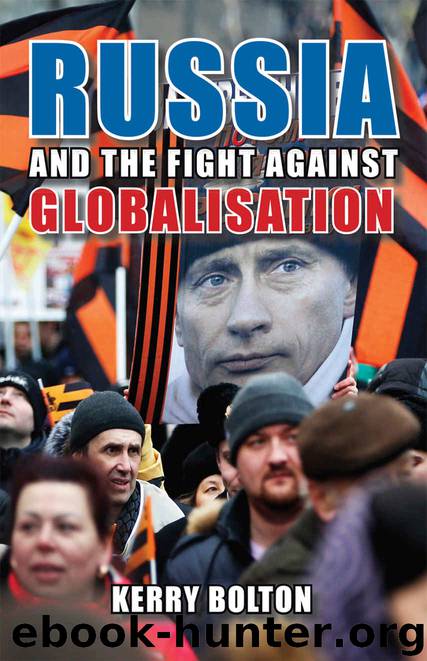Russia and the Fight Against Globalisation by Kerry Bolton

Author:Kerry Bolton [Bolton, Kerry]
Language: eng
Format: epub
Publisher: Black House Publishing Ltd
Published: 2018-08-03T04:00:00+00:00
Revival of Orthodox Church
In June 1941, with the attack of Germany on Russia, Stalin is said to have had a nervous breakdown and to have secluded himself in his dacha for three days. Another theory is that he was testing the loyalty of his confidantes to see whether they would accept his resignation.[473] Others claim that he retired to meditate and pray. At the same time Metropolitan Elias Karam of Lebanon was also praying for three days on the fate of Russia. He sent a telegram to Stalin asking that for Russia to be saved the Kremlin churches must be opened, and that a procession of the cross should carry the Kazan Icon of the Mother of God, the holiest icon of the Russian Orthodox Church. The icon was carried around Leningrad, and Moscow, was with the Russian troops at Stalingrad, and a prayer service was held prior to the battle. The icon was taken to all crucial points of the frontline. The priests carrying the icon led the troops under intense fire. The presence of the icon had an intense impact on the troops; even the sceptics. [474]
On September 4 1943, the exiled Metropolitan Sergei and two other Metropolitans were summoned to the Kremlin to meet with Stalin. He told them he had decided to restore the Patriarchate, reopen churches and seminaries, and resume the publication of The Journal of the Moscow Patriarchate. Stalin reminisced at length about his time at seminary. As for his intentions to restore the Patriarchate and churches, he said to Sergei, ‘Your Grace, that’s all I can do for you now’.[475] Daniela Kalkandijeva opines that, with the setting up of Moscow as the centre of world Orthodoxy at Stalin’s suggestion, it would nonetheless ‘be wrong to think that the church was just a pawn on Stalin’s chessboard’.[476] The churches were already being reopened in 1941. This was not merely a strategy caused by the German invasion, to mobilise the Russian masses. In 1938 the Communist party declared that the faithful were also loyal Soviet subjects. Further, in a reversal of Bolshevist dogma, the party and the Soviet Academy of Sciences stated that the Church had provided a ‘progressive role’ in Russian history. In 1941 even Yaroslavsky, head of the Militant Godless, criticized those who still regarded the millions of faithful as superstitious fools.[477] The 1943 meeting with Sergei formalized the process. He was elected Patriarch by the Synod that year. The Council of the Russian Orthodox Church, headed by NKVD Colonel G.G. Karpov was established. Karpov, who had been responsible for the repression of religion during the 1930s, now worked for state support for the church.
In November 1943 the Council of People’s Commissars adopted Decree No. 1325, ‘On the Procedure for Opening Churches’. In 1944 206 churches were opened; in 1945, 510. The Orthodox Church flourished. On Easter night 1944 the thirty churches in Moscow were attended by 120,000. Attendance throughout Russia was overflowing. Worshippers included many Soviet officers. Even Communist party functionaries and NKVD agents had their children baptized.
Download
This site does not store any files on its server. We only index and link to content provided by other sites. Please contact the content providers to delete copyright contents if any and email us, we'll remove relevant links or contents immediately.
The Meaning of the Library by unknow(2386)
Six Billion Shoppers by Porter Erisman(2229)
Why Nations Fail: The Origins of Power, Prosperity, and Poverty by Daron Acemoglu & James Robinson(2176)
No Time to Say Goodbye(1998)
Red Notice by Bill Browder(1929)
The Economist [T6, 22 Thg9 2017] by The Economist(1844)
Currency Trading For Dummies by Brian Dolan(1790)
Thank You for Being Late by Thomas L. Friedman(1679)
Bitcoin: The Ultimate Guide to the World of Bitcoin, Bitcoin Mining, Bitcoin Investing, Blockchain Technology, Cryptocurrency (2nd Edition) by Ikuya Takashima(1615)
Amazon FBA: Amazon FBA Blackbook: Everything You Need To Know to Start Your Amazon Business Empire (Amazon Empire, FBA Mastery) by John Fisher(1496)
Coffee: From Bean to Barista by Robert W. Thurston(1420)
The Future Is Asian by Parag Khanna(1401)
The Great Economists by Linda Yueh(1391)
Capitalism Without Capital: The Rise of the Intangible Economy by Jonathan Haskel(1342)
Pocket World in Figures 2018 by The Economist(1329)
How Money Got Free: Bitcoin and the Fight for the Future of Finance by Brian Patrick Eha(1322)
Grave New World by Stephen D. King(1316)
The Sex Business by Economist(1280)
Cultural Intelligence by David C. Thomas(1204)
